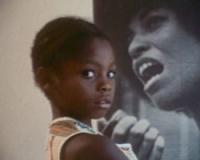Creating an alternate cinematic voice to that of mainstream cinema was a defining characteristic of the L.A. Rebellion group of Black filmmakers. The consciousness of this goal is perhaps nowhere as acutely evident as in the work of Haile Gerima. The well-documented story behind his 1972 student film, Child of Resistance, is that it evolved out of a dream Gerima had after seeing Angela Davis handcuffed. Davis had been an Assistant Professor of Philosophy at UCLA while Gerima was a student and as a political activist was an icon of Black Power and resistance, so when Gerima saw footage of her 1970 arrest on television, it resulted in the vivid dream that inspired the film. This instance of a real-life injustice inspiring a film would be repeated with Bush Mama (1976), a film that originated partly from Gerima seeing a Black woman evicted from her home in the middle of a Chicago winter. Gerima felt that audiences, even some Black audiences, simply did not believe these kinds of injustices were perpetrated in real life. He resented that he was constantly expected to convince viewers that the events portrayed in his films were actually representative of a Black experience in the U.S., as though it were his responsibility to educate viewers on the realities of societal oppression.
Gerima’s choice to use surrealism in Child of Resistance to poignantly explore themes of the social imprisonment of Black women serves his student film well, allowing a poetic exploration of filmic space. Also considering the rejection of linearity, many critics see here Italian neorealist influences and sensibilities in Gerima’s work, along with a narrative structure that would have suited a more socially conscious Luis Buñuel.

Child of Resistance’s subversive visual narrative is complemented by a brutally honest monologue track that gives the viewer intimate insight into the thoughts and fears of the subjugated female protagonist. Through her representation of the social status of Black women as a whole, psychological social injustices are explored physically as well as literally in an examination of the external forces that keep this oppression alive. Gerima places his character physically behind bars and in chains. She is judged literally by a jury of white men and women. Child of Resistance succeeds as a social smack in the face, giving voice and bringing consciousness to an otherwise un-represented human struggle.
Gerima’s theatrical training was particularly evident in Child of Resistance as the parallel universe he constructs in the film is staged in a theatrical and characterizing way. Gerima uses this parallel world to accent the absurdities each of the characters face as a collective Black race. Angela Davis, played by the L.A. Rebellion’s beloved Barbara O (Barbara O. Jones) is the enlightened voice in a chaotic and indulgent world. Her gaze penetrates the illusions, cutting through them with clarity of mind and language. Although she is in prison, her mind is free.
There is a symbiotic relationship between Davis’ consciousness and what ends up happening in the film’s final act. Davis is a witness to many of the horrors outside her cell. She communicates her feelings and her raw emotions and certainly her thoughts to the outside world (conveyed through the use of a voice over). These aspects of her consciousness ripple out into the world and influence it. Therefore, though she is a “prisoner” she possesses the archetype of the Freedom Fighter or the Liberator. While attending UCLA, the L.A. Rebellion filmmakers would attend each other’s screenings not only simply to see each other’s work, but also to come to each other’s defense during the post-screening critique sessions, where many students and professors, often white, would misunderstand the work being shown. According to Gerima, students from many different departments came to see his screening of Child of Resistance because of his reputation of being loud and opinionated about film. Yet even though much of the audience came ready to criticize his work, the film was received incredibly well, to the point that the audience as a group called down the professor’s criticism.
—Jeff McCluskey, Iyabo Kwayana and Bryan Wuest






 Mobile Navigation
Mobile Navigation

